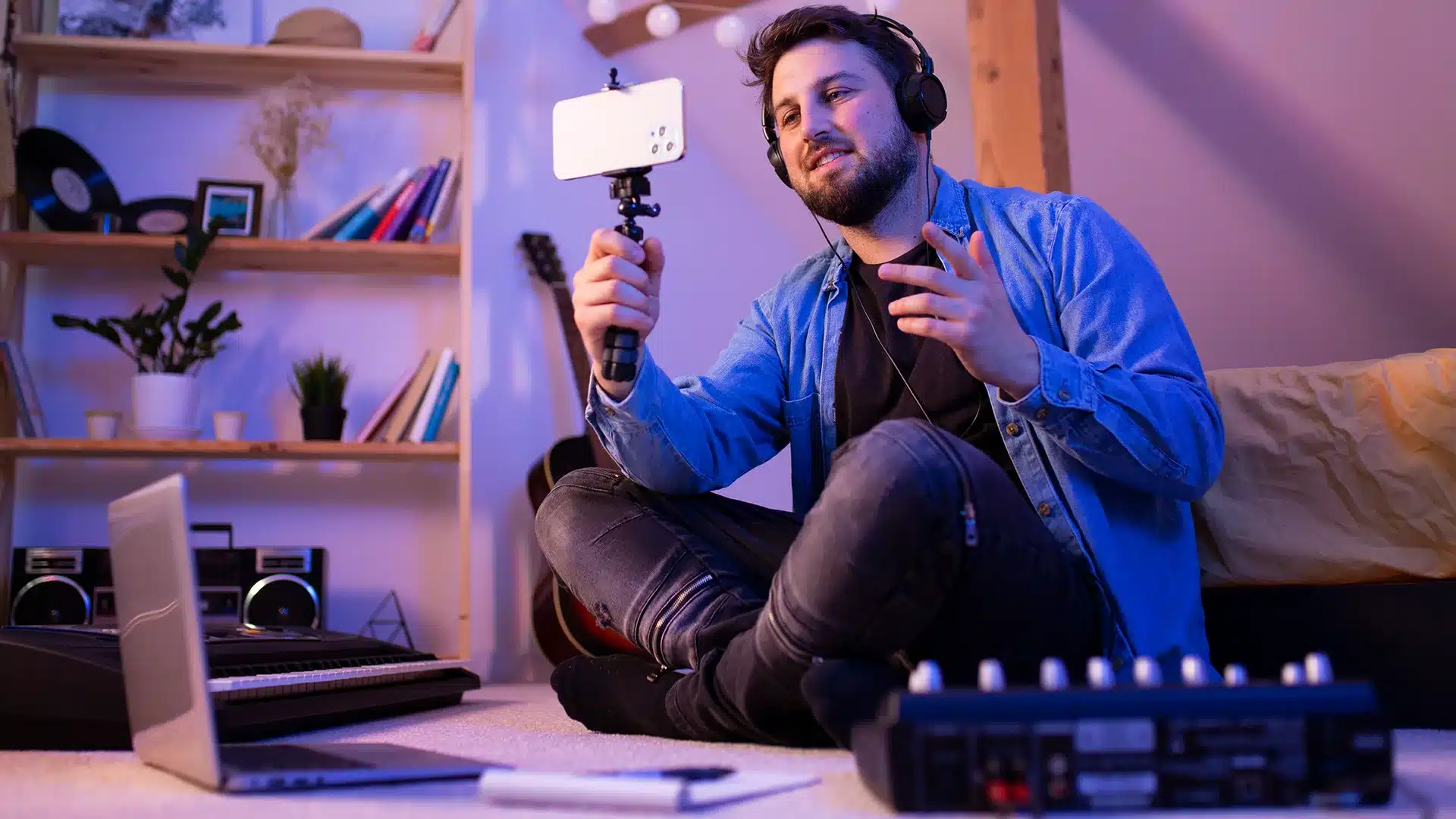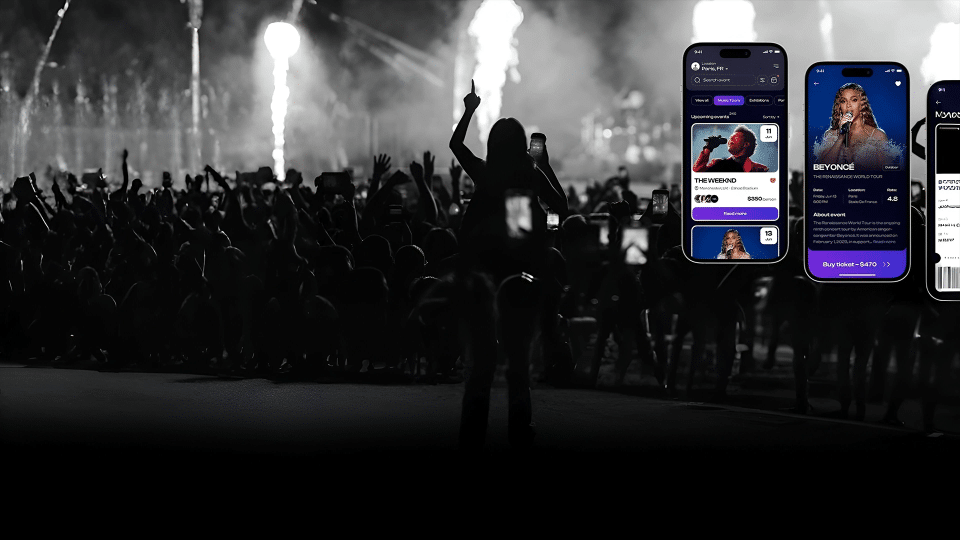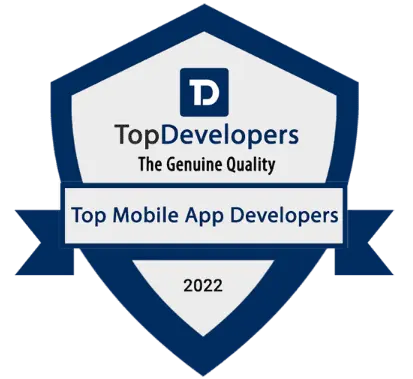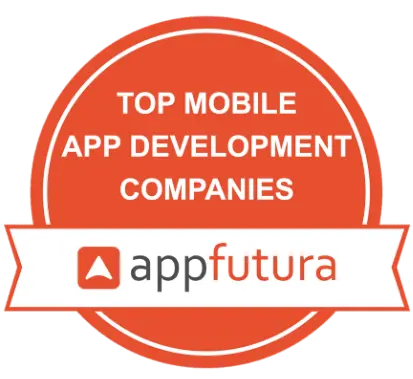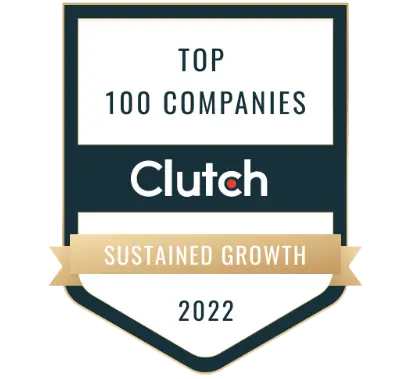What if your concept for the next Instagram or TikTok could attract millions of users and, each month that goes by, some company launches it first? By 2025, to say that social media is rapidly evolving is an understatement; if you aren’t paying attention to the right moment, you are losing a multi-million dollar opportunity.
As of today, there are 5.17 billion social media users worldwide, just over 64 percent of the world’s population. In the U.S. alone, 312 million people use social media platforms which makes it a highly competitive, yet advantageous, market for social media app developers. Social networks like TikTok changing rules of how content is being engaged with and LinkedIn paving the way for professional networking apps have started building great competition to create apps this way.
Here’s the truth, before you jump to create it, you need to know the approximate social media app development cost. Your budget will dictate your app’s design, features, and it will also dictate whether it is scalable long-term (if you want to create an app that implements AI-driven personalized engagement tools).
Industry insights: The global social media market is expected to reach $310 billion in 2030, with a significant portion of this potential growth driven by AI-guided user experiences and social media solutions that are more niche.
In this social media app development cost guide, we will outline how much a social media app costs to develop, the different types of apps, the different aspects of development costs, ways to save costs on a social media app project, and how NineHertz can develop an AI-guided social media app to launch in 2025.
How Much Does It Cost to Build a Social Media App? (Overview)
In 2025, the cost of development for a social media app can run as low as $45,000, and upwards of $300,000, depending on features, complexity, target audience, and any advanced AI powered features you may choose to integrate.
A basic MVP, or minimum viable product, of the app, with standard features (user profiles, chat, and content posts) could start around /45,000-$80,000; while a full-fledged social media app, powered by AI, advanced personalization, real-time analytics features, and incorporating AR/VR elements, could exceed $250,000-$300,000.
Here’s a quick cost breakdown based on app complexity:
| App Type | Key Features | Estimated Cost (USD) | Development Timeline | ||
|---|---|---|---|---|---|
| Basic Social Networking App | Profiles, posts, likes, comments, basic messaging | $45,000 – $80,000 | 3-5 months | ||
| Mid-Level App | Advanced search, video sharing, push notifications, group chats | $80,000 – $150,000 | 5-8 months
|
||
| AI-Powered Social Media App | AI recommendations, sentiment analysis, personalized feeds, image/video recognition, analytics | $150,000 – $250,000+ | 8-12 months | ||
| Premium/Niche Platform | AR/VR integration, live streaming, in-app monetization tools, high-level AI-driven engagement | $250,000 – $300,000+ | 10-15 months |
Pro Tip: Start with an MVP to validate your idea before committing to a high-budget, full-scale platform. This approach can save up to 40% in initial development costs.
Types of Social Media Apps
Every social media app is unique and these apps can serve a variety of purposes to meet the needs of the audience. When considering the cost of developing a social media app, it is critically important to clarify the type of app because every type of social media app will have differing complexity, audience needs, and needed features.
Here’s a breakdown of the basic types of social media apps, example features , real world examples of successful apps, and an understanding of how these may impact development costs:
1. Social Networking Apps
Objective of the App: To connect people for personal or professional interactions.
Examples: Facebook, LinkedIn, Threads.
Key Features:
- User profiles and friend lists
- News feed or timeline
- Messaging and group chats
- Notifications and tagging
- Content creation tools (text, photo, video)
Development Cost:
Basic networking app: $50,000-$100,000
Advanced AI-powered networking app: $120,000-$200,000+
Pro Tip: Integrating AI-powered content recommendations can boost engagement but adds 15-25% to your development cost.
2. Media Sharing Apps
Objective of the App: To enable users to upload, share, and engage with photos, videos, and creative content.
Examples: Instagram, TikTok, Snapchat.
Key Features:
- Photo and video upload tools
- Filters and editing capabilities
- Stories and reels
- AI-based content suggestions
- Live streaming features
Development Cost:
Basic photo-sharing app: $60,000-$110,000
AI-driven video-first app: $150,000-$250,000+
3. Discussion Forums & Community Apps
Objective of the App: To facilitate topic-based discussions and knowledge exchange.
Examples: Reddit, Quora.
Key Features:
- Discussion threads and voting systems
- Topic categorization
- User reputation points or badges
- Content moderation tools
- AI-driven spam and content filtering
Development Cost:
Basic community platform: $45,000-$90,000
Advanced AI moderation system: $120,000-$180,000+
4. Professional Networking Apps
Objective of the App: To help professionals connect, share expertise, and find opportunities.
Examples: LinkedIn, Xing.
Key Features:
- Career-focused profiles
- Job posting and application system
- Networking suggestions
- AI-based candidate matching
- Professional content sharing
Development Cost:
Basic professional app: $70,000–$120,000
AI-powered career matching app: $150,000–$220,000+
5. Niche & Interest-Based Apps
Objective of the App: To target specific communities or interests such as fitness, travel, gaming, or dating.
Examples: Strava (fitness), TripAdvisor (travel), Bumble (dating).
Key Features:
- Community-specific tools (e.g., workout tracking, trip planning)
- Event creation and participation
- In-app purchases or subscriptions
- AI-based interest matching
Development Cost:
Basic niche platform: $50,000–$90,000
Highly customized AI platform: $120,000–$200,000+
Fun Fact: According to Statista (2025), niche social media platforms are seeing 25% faster annual growth than mainstream networks, especially among Gen Z users.
Factors That Affect Social Media App Development Cost
While it is clear that the cost to develop a social media app can be impacted by many factors, including features you want to include, and the company location of your development team. Recognizing these factors will help you plan your budget, and will prevent you from being shocked by huge development costs down the line.
1. Type of Social Media Platform
The type of social media application you are intending to develop will have a significant influence over the cost of creating the application.
- Networking apps like LinkedIn and Facebook will need sophisticated algorithms for friend suggestions and professional matching, as well as group management features.
- Media sharing apps like Instagram and TikTok require to support high quality video processing and image optimization for image storage.
- Community and discussion apps like Reddit and Quora will need moderation tools and threaded discussions with some form of categorization for content.
- Messaging platforms like WhatsApp and Messenger must deliver real-time data transfers with encryption protocols
Cost Impact: A simple networking app will cost $40,000 – $60,000. A complex and feature-rich video-sharing app with streaming video and video editing features like Instagram or Tik Tok, could be over $250.000.
Pro Tip: Make sure to specify exact niche of your app, so that you do not include unnecessary features and parameters, which will add to the costs during development.
2. App Complexity and Features
The number of features you put into an app will dictate you’re cost for developing the app as well as the time it takes to develop .
Basic Features:
- User registration/login
- Profile creation
- Newsfeed/timeline
- Basic chat
Advanced Features:
- AI-driven recommendations (AI-driven social media app algorithms be limited to data science development resources to grow engagement.)
- AR filters (like Snapchat lenses)
- Live streaming
- In-app payments
- AI content moderation
Example: TikTok’s AI-driven “For You” page used machine learning (ML) engineers, which really drove up the expense of their original app development.
Cost Impact: Adding advanced AI and AR features can add $50,000 – $120,000+ to your cost to develop.
Pro Tip: First build a “minimum viable product” (MVP) with your core features, and then decide if you will scale based on user feedback.
3. Platform Decision: iOS, Android, or Cross-Platform
Deciding whether to create for iOS, Android or both will greatly affect your budget.
- iOS Development: It hs a higher cost than Android as Apple has stricter review process to get apps approved but also typically offers more monetization opportunities compared to Android (especially in the U.S.).
- Android Development: Here you will attract a larger global audience and get more people to test your app; however, you will need to test on a wider range of devices.
- Cross-Platform Development: Here you can save money and time using tools such as Flutter or React Native. These tools give you on codebase that can be used for multiple platforms and can significantly reduce costs.
Interesting Stat: As per Statista, 2025, in the United States, iOS users make up 53% of mobile app revenue, which can make iOS a lucrative first option for many startups.
Cost impact: For both the platforms, building native apps would generally costs 30-40% more than one cross-platform app.
Pro Tip: If you’re going for the U.S. market first, launch the app for iOS first to own the higher ARPU (Average Revenue Per User).
4. UI/UX Design Quality
In social media, design is more than just appearance; it’s for retaining users.
- Basic UI: Contains simple navigation along with static elements.
- Premium UI/UX: Includes some custom animations, interactive transitions, and dynamic layouts.
- Interesting Stat: As per the Stanford Web Credibility Project, 94% of first impressions are related to design.
- Cost impact: Basic design ranges between $5,000-10,000; on the other hand, advanced, custom UI/UX may push the cost up by $20,000-50,000.
5. Scalable Backend Infrastructure
Your app’s backend is the brain of your app. Scability is essential for growth.
-
Cloud Hosting: You can use AWS, Google Cloud, or Azure for flexibility and scalability.
For Database: SQL or NoSQL options depending on real-time needs.
Infrastructure needs to include components like Load Balancers & Caching for spikes in traffic.
For Example: Instagram was built on infrastructure of Facebook once they were acquired in 2012. The initial scaling would have cost too much for them to build independently.
Cost impact: The cost of backend development can be 30-40% of the total development costs of the app.
Pro Tip: Choose scalable cloud hosting/domain service as starting point. It will cost more to migrate later.
6. Security and Compliance
In the current age, data privacy is everything.
- Encrypted data: It protects user information.
- GDPR & CCPA: You need to comply with both if you want to be in the U.S. and EU market
- Two-factor authentication (2FA): It adds more protections or layers of security.
Interesting Stat: As per Ping Identity report, after a data breach 67% of users will abandon an app forever.
Cost Consideration: Security features can bump budget upto $5,000-$20,000 but it is crucial for promoting trust and compliance.
Pro Tip: Do not skimp on security: one breach can ruin your brand reputation, and your future revenue!
7. AI and Emerging Technologies
A social media app that employs AI can offer personalization, better content moderation, and user engagement.
- AI enabled chatbots for customer support
- Machine learning for personalized feeds
- AR/VR for immersive experiences
Interesting Stat: AI in social media is expected to reach $6.9 million by 2027 as reported by “MarketsandMarkets”.
Cost impact: Integrating AI will be increased by $20,000 – $100,000 depending on complexity
Pro Tip: If using AI for the first time and in the early stages of development, use APIs as they are more cost-effective than building your own algorithms.
8. Team Location and Expertise
Developer rates vary dramatically by region.
| Region | Hourly Rate (Avg) | Quality Level |
|---|---|---|
| U.S. & Canada | $80-$150 | Very High |
| Eastern Europe | $40-$70 | High |
| India & SEA | $25-$50 | Good |
Cost Impact: A U.S.-based development team might cost 3-4x more than outsourcing to India without compromising quality if you choose an experienced agency like The NineHertz.
Pro Tip: Hire a hybrid team where the core strategy is in-house and the development team is outsourced.
How Can We Reduce Social Media App Development Costs?
To develop a social media app does not always mean you have to spend a lot of money. The social media app development cost for large platforms can reach the hundreds of thousands, but smart planning, technological decisions, and resource utilization can help save you money, while also keeping quality high.
Below are the best ways to cut down on the costs of your social media app development, with additional examples from real projects and industry experts.
1. Start with a Minimum Viable Product (MVP)
Releasing a Minimum Viable Product will allow you to launch with only core features and test market validation and get feedback from users before you dedicate yourself to developing the full application.
For example: Instagram was first launched with features like photo uploads and filters only and slowly rolled out new features such as Stories, IGTV, and Reels based on market opportunity and user demand.
Cost Impact: Launching as an MVP could potentially make your initial development costs 30-50% less expensive as compared to launching a fully-loaded platform from day one.
Pro Tip: Focus on features that address the audiences’ pain points, and skip “nice-to-have” features, until your app gains traction.
2. Utilize Cross-Platform Development Frameworks
Instead of developing separate native apps for iOS and Android devices, use of frameworks like Flutter or React Native allow you to write one codebase and deploy to both platforms.
For example, Alibaba and BMW have maximized the Flutter platform to minimize development schedules and costs while ensuring their apps perform consistently across platforms.
Cost Impact: Save 20-40% on development timelines and maintainability.
Pro Tip: When selecting a framework, find one with good community support and regular updates to help maintain stability over time.
3. Use Pre-Made Templates & UI Kits
Instead of designing every screen from scratch consider using premium templates and UI kits. This will save you a ton of time.
For example, many startups will purchase Figma or ThemeForest UI kits and modify them to fit the brand, essentially cutting the cost of designing by almost half.
Cost Impact: Save on design hours by 25-35%
Pro Tip: Make sure the template you choose can be scaled and can accommodate future feature development.
4. Hire Capable Offshore Developers
Countries like India, Ukraine, and the Philippines have highly capable developers available at a fraction of U.S. developers’ rates.
For example, many U.S. startups retain dedicated teams through The NineHertz, which shortens total development cost without sacrificing quality.
Cost Impact: An offshore developers hourly rates can drop from $100-$150 (U.S.) down to $25-$50.
Pro Tip: Screen offshore teams carefully by reviewing portfolios, client testimonials, and conducting trial projects before committing.
5. Apply Agile Development Methodologies
Agile methodologies lead to faster releases, maximize flexibility, and limits inefficient chances of expense later on in the development process.
For example, Slack is able to test new features quickly with agile sprints and respond to user feedback without incurring huge expenses for redevelopment.
Cost Savings: Saves 15 – 25% of potential rework costs.
Pro Tip: Weekly stand-up meetings to recap who is doing what and uncover issues sooner rather than later.
6. Use Third-party APIs for Complexity
Instead of developing every feature from scratch, you can use APIs that are already available (messaging, video calls, payments, analytics).
Examples are:
Chat: Twilio
Payments: Stripe
Analytics: Firebase
Cost Savings: Saves thousands in development costs and ongoing maintenance.
Pro Tip: Choose APIs that have transparent pricing and find the scalable option to prevent the risk you might pay too much as your user base increases.
7. Optimize Cloud Costs
There are lots of great cloud offers, for example AWS, Google Cloud, or Azure that allow you to only pay for what you use, and enable scalability.
For example, Pinterest migrated to AWS to scale strategically, and infrastructure costs when traffic was low.
Cost Savings: Saves 20 – 30% of annual expenses.
Pro Tip: Get your auto-scaling and monitoring tools in place as soon as possible to avoid wasting resources.
High-Cost Approach vs. Cost-Effective Approach
| Factor | High-Cost Approach | Cost-Effective Approach | Estimated Savings |
|---|---|---|---|
| Development Strategy | Full-feature build at launch | MVP + phased rollouts | 30-50% |
| Platform Choice | Separate native apps | Cross-platform (Flutter/React Native) | 20-40% |
| UI Design | Fully custom design | Premium templates + customization | 25-35% |
| Team Location | U.S.-based developers | Offshore dedicated team | 40–60% |
| Feature Development | Built from scratch | API integrations | 15–30% |
| Hosting | Fixed high-capacity servers | Scalable cloud hosting | 20–30% |
Finding ways to save money does not mean sacrificing quality. It means making fewer poor choices! Starting small, utilizing modern frameworks, and outsourcing responsibly can help you build a high quality, high performing, AI social media app while maintaining some sense of control over the social media app development costs.
Social Media App Development Features
When designing your social media application, picking a definitive set of features is one of the most important aspects that influence the total cost of social media app development. You can add that many features to increase competitiveness, however, you need to know that adding more features can also drive up costs. The challenge here is to establish a healthy balance between functionality, user experience, and budget.
Below we breakdown the core, advanced, and AI features and how they impact the total cost of social media app development.
1. Core Features (Essential for MVP Launch)
These are the must-have features to make your app functional from day one.
| Feature | Description | Cost Impact |
| User Registration & Login | Email, phone, or social sign-up; supports single sign-on (SSO) | Low |
| User Profiles | Editable bios, profile pictures, and privacy settings. | Low |
| News Feed / Timeline | Displays posts, images, or videos from connections or followed accounts. | Medium |
| Post Creation & Editing | Ability to upload photos, videos, and text content. | Medium |
| Likes, Comments & Shares | Basic engagement tools to encourage interaction. | Low |
| Search & Discovery | Search for people, hashtags, and content categories. | Medium |
| Push Notifications | Alerts for likes, comments, new messages, and updates. | Low |
| Basic Messaging | Direct text communication between users. | Medium |
For example: The first version of Instagram had just these essentials: photo uploads, filters, profiles, and a feed, which helped it launch quickly and cost-effectively.
2. Advanced Features (Boost Engagement & Retention)
Once your MVP gains traction, adding advanced features can enhance the user experience.
| Feature | Description | Cost Impact |
| Live Streaming | Real-time video sharing with followers. | High |
| Stories / Status Updates | Short-lived content for higher engagement. | Medium |
| Advanced Messaging | Voice notes, GIFs, group chats, and media sharing. | Medium |
| In-App Purchases | Monetization through premium content, coins, or stickers. | Medium |
| Content Moderation Tools | AI or manual systems to flag inappropriate content. | High |
| Event Creation & Groups | Community building through events or group discussions. | Medium |
| Analytics Dashboard for Creators | Insights into engagement, reach, and demographics. | High |
| Multi-Language Support | Expands global reach. | Medium |
3. AI-Powered Features (Future-Ready Enhancements)
With AI becoming a game-changer in 2025, integrating AI-powered social media app features can set your platform apart.
| Feature | Description | Cost Impact |
| AI Content Recommendations | Personalized feeds using machine learning algorithms. | High |
| AI Chatbots for Support | Automated, 24/7 customer assistance. | Medium |
| AI Image & Video Recognition | Tagging people, detecting inappropriate content, or auto-generating captions. | High |
| AI-Powered Search | Contextual search that understands intent, not just keywords. | High |
| Voice-to-Text & Translation | Enables accessibility and global communication. | Medium |
| Predictive Analytics for Creators | Suggests optimal posting times and trending content ideas. | High |
For example: The success of TikTok largely depends on its AI-powered “For You” page, which recommends hyper-relevant content, keeping users hooked and increasing ad revenue.
4. Feature Development Cost Breakdown
The cost of social media app development varies depending on feature complexity, technology stack, and whether you choose native or cross-platform development.
| Feature Set | Estimated Development Hours | Cost (U.S. Rates: $100–$150/hr) | Cost (Offshore Rates: $25–$50/hr) |
| Core Features | 400–600 hrs | $40,000-$90,000 | $10,000-$30,000 |
| Advanced Features | 500–800 hrs | $50,000-$120,000 | $12,500-$40,000 |
| AI-Powered Features | 800–1000 hrs | $60,000-$150,000 | $15,000-$50,000 |
5. Choosing the Right Features Without Breaking the Bank
- The goal is to first develop an MVP to launch faster and cheaper.
- Consider surveying users to validate features beforehand.
- Utilize third-party APIs to justify your time and spending. This is particularly useful if you require more
- complex functions like payment processing, streaming video, or chat.
- Have a strategy in place to scale up so that existing features can be enhanced later without too much upfront development work.
Pro Tip: Adding too many features at once may increase the likelihood of bugs as well as your timeline to launch. Build your item in phases, so you can stay on budget as well as make sure you are delivering quality.
Thus, your social media app will have strategically mixed minimum features, engagement features, and AI-enhanced features that will provide performance and scalability down the road and at a cost that will not grow excessively high during social media app development.
How Can NineHertz Help You in Building an AI-Powered Social Media App?
Creating a social media app that stands out and succeeds in 2025 will not just mean writing code, it means creating an app that attracts the users, engages the users, and scales in a highly competitive environment. This is where The NineHertz can be your trusted partner to support the development of your app as a startup, enterprise, or global brand.
With over 16 years in the industry and 1,800+ mobile applications in our portfolio, The NineHertz applies creativity, innovation, and advanced technology to help bring your social media concept to life.
1. Expertise in AI-Driven Social Media Development
The NineHertz is an early adopter for AI-powered solutions. AI integrations put your social media app in a category of its own, like TikTok’s recommendation engine, or Instagram’s Explore tab, to provide obvious help for application greatness.
Some assessment we provide under AI:
- AI-based content recommendation engines for personalized social media feeds.
- Predictive analytics for creators to optimize, for example, what time of day to post.
- AI for image and video recognition to automatically tag and filter content.
- AI-based chatbots for faster consumer responses.
2. Full-Cycle Development Process
The NineHertz uses verified agile processes and a full-cycle development process from ideation to post-launch!
- Market Research & Competitor Analysis: Identifying gaps and opportunities.
- UI/UX Design: Crafting visually appealing, intuitive interfaces.
- MVP Development: Rapid deployment of core features for quick market entry.
- Feature Expansion: Gradual addition of advanced and AI-powered functionalities.
- Testing & QA: Rigorous functional, performance, and security testing.
- Launch & Support: Continuous upgrades, bug fixes, and scalability planning.
3. Cost-Effective Global Delivery Model
The NineHertz provides different engagement models, you can hire and leverage US-based developers $100-$150/hr for premium projects, or offshore teams to save costs at $25-$50/hr. A blended model means you get high-quality delivery without broker fees.
4. Industry Expertise & Client Trust
- The NineHertz is ranked as one of the top mobile app development companies by Clutch, GoodFirms, AppFutura.
- Has assisted clients in 50+ countries with in media, entertainment, e-commerce, and gaming.
- Has 95% client satisfaction rate with repeat partnerships for multiple projects.
5. More than Development – Growth Partnership
The NineHertz does more than build your app, they help you grow your app. In a partnership, their team will provide:
- App Store Optimization (ASO) for more visibility.
- Monetization strategy consulting: in-app versus ads.
- User analytics & performance tracking for data-driven improvements.
Fun Fact: Statista indicates that the US had over 302 million social media users in 2025. The US is certainly a significant market for AI-powered social media platforms. Working with The NineHertz will ensure your app is optimized for local and global audiences.
Whether you are building the next Instagram, a community platform for your favorite cat or dog breeds, or a user-controlled, AI-powered content sharing platform, The NineHertz has the know-how, skills, resources, and vision to transform your idea into a successful digital platform.
Conclusion
The cost for developing a social media application can vary widely in 2025. Costs will fluctuate based on how complex the app will be, features, platform, and inclusion of AI capabilities. A simple application could cost on the lower end from $40,000 to $80,000, while an AI-rich application with advanced personalization, analytics, and automation can readily be from $150,000 to $300,000+.
However, costs can vary dramatically, but the investment is more than just cost. With the current acceleration in growth and comfort with AI in the past year, AI-powered social media applications can offer users an unmatched engagement experience, smart delivery content feeding multi-channel delivery from partners, best-in-class automation intelligence, and customer satisfaction that 100’s of thousands of brands can’t. In reality, social media and engagement is an impersonal experience for consumers when you actually push a brand out to 5.17 billion social media users globally in 2025.
Assessing your development partner is key to success. The NineHertz isn’t a dev team, but a marketplace partner. They know market forces, how consumer behavior evolves, and the tech trends before you know them. However, they may never talk to your end-users directly throughout their onboarding experience. From the time, you have an idea and want to build the application until you launch and optimize post-app launch, The NineHertz positions you with a logical cost structure, scalability, and performance-growth approach plan.
Final Tip: If you are developing an app for the US market, remember design appeal, mobile performance, and personalization are arguably the most important factors that will lead to user retention. In an ever-changing world where trends change overnight, your optimized app experience with proper AI integration will ensure that you will have a technology-based competitive edge.
Frequently Asked Questions
Let us discuss some of the frequently asked questions related to the cost of social media app development:
1. What is the average cost of social media app development in 2025?
The typical range for social media app development is $40,000 for basic apps, to over $300,000 for advanced AI-powered platforms. Ultimately the cost will depend on the design complexity, features, and where the development takes place.
2. How long does it take to develop a social media app?
In general, basic social media apps very commonly take anywhere from 4 to 6 months to build, while more complex apps that include AI and machine learning typically take between 9 and 12 months, if not longer (when be advanced testing, AI model training, and scaling).
3. Why should I add AI features to my social media app?
AI features such as personalized content recommendations, predictive analytics, automated chatbots and image recognition can all be added into your app. Together they can contribute positively to user engagement and retention, giving your app an advantage in a crowded marketplace.
4. Can The NineHertz develop a custom AI-powered social media app for my niche audience?
Yes. The NineHertz specializes in building custom apps powered by artificial intelligence, built for your specific industry, demographics, and engagement. The NineHertz will ensure your platform meets the intended business goals.
Great Together!


